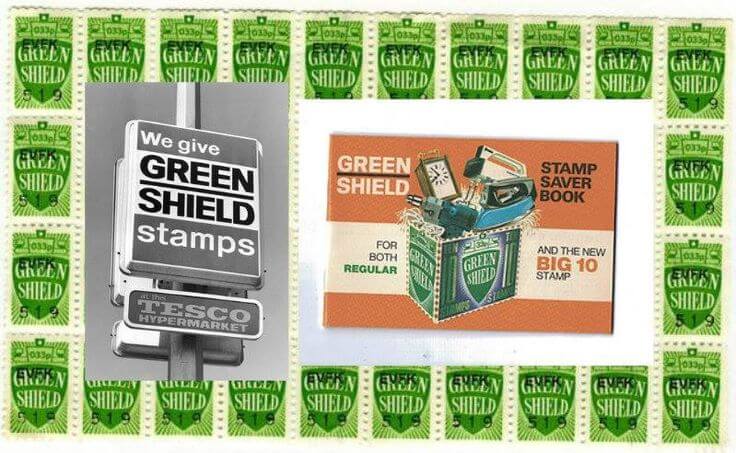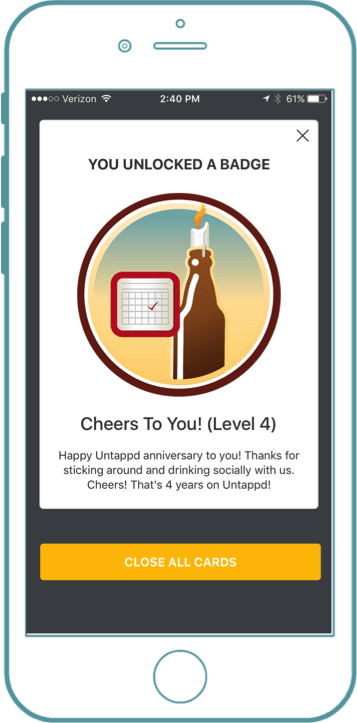A story began in the 1700s when American merchants as a sign of appreciation and encouragement for future purchases gave their customers copper tokens. Those coins could be used for later buying. Although, as retailers agreed on, that was a too costly way for customer retention, so in 1891 coins were replaced by stamps.

Green Shield stamps became the first loyalty program for customer retention. A selected range of merchants offered that advantage and could be found in a special catalog.
As time went on certain retailers came up with their own approaches to engage customers. One of such programs was called “box tops”—certain coupons printed right on the product’s packages that a customer could exchange for the next purchase.
In 1981 the Frequent Flier program was launched by American Airlines which is now known as an AAdvantage program with over 50 million members.
In order to monitor customer loyalty in the 1990’s more and more retailers implemented a card-based loyalty program. They still remain popular for most brands. Although nowadays most successful loyalty programs don’t require for customers to hold cards in the wallet—an ordinary smartphone is enough!
One of the pioneers in creating customer loyalty programs for mobile was Starbucks where a mobile app not only gathers rewards for purchases but can also act as a payment method. By the way, mobile apps have much more to offer both for customers and business owners: additional points for social media shares, referrals, feedbacks for the first ones that works perfectly as an additional marketing tool for the second ones driving new customers and growing revenue.
Yet the simplest example here is Dunkin Donuts where a customer goes through a certain journey: spends money, earns bonuses, and after a while gets a free coffee.

Why invest in mobile loyalty apps?
Let’s see why would a random customer choose a loyalty app over cards or so:
-
Mobile device preference
You may consider different forms of loyalty program implementation including the already popular cards. But if you take a serious look at today’s customers' expectations you will see that most of them tend to use iOS or Android-based mobile devices more often than previously.
-
Balance management
Would you personally like to control your loyalty program balance if you were a customer? For some people, it is some kind of a game gaining more and more awards like in some random video game. Mobile apps give them such a chance: in some kind of digital wallet (personal account), they can see their current balance, potential discounts, special offers, unique programs, etc. Other forms of loyalty programs don’t provide that convenience.
-
Changing expectations
People tend to constantly try out new things. With ordinary cards, you won’t be able to offer much. But with mobile apps, you can renovate your offers, designs, modes so your clients will always be able to satisfy their changing preferences.
-
Innovation
The world continues to become better, more convenient. Customers prefer new approaches. Your competitors grab new opportunities to offer a better service in order to become the first ones in the sphere. Why should you lag behind?
In the end, customers have so many opportunities to switch from one brand to the other. It means once they see a poor loyalty program they tend to search for a better one in a big “ocean” of retailers. That can greatly affect your company’s revenue. As some researchers say, just a 5 percent increase in loyalty from customers can elevate your profits from 25 to 100 percent. Convincing enough?
Not to mention the possibility to study and measure the customer’s behavior. People are more willing to give information about themselves in exchange for better loyalty options. Your marketing team will be thrilled to use this data for increasing your revenue.
What does a good loyalty application look like?
A really good loyalty app shouldn’t just promote the company’s products but rather give real value to its customers. Otherwise, programs that solely concentrate on earning some points from purchases tend to completely fail within 2 years term.
Research by Bond Brand Loyalty reports what customers recognize as indicators of a really great loyalty app:
- Meets customers needs
- Engages customers into participation
- Improves brand experience
- Easy exchange system
- Consistent with brand expectations
- Provides attractive benefits
- Requires an understandable level of efforts and time to earn rewards
- Has a clear system of a number of rewards earned by each dollar spent
- Offers various ways to earn benefits
The list can be continued. Although everyone would agree that the main principles when developing a great loyalty app should be:
#1. Super simple to use
The most successful apps are the ones where all aspects of customer engagement are intuitive and easy to use. All rewards calculations should be automatic. A user can easily figure out how to gain and redeem rewards.
As an example of a much easier way of reporting to a customer about a loyalty program status, Air New Zealand should be mentioned. All communication is done via email (it is a perfect way to start a loyalty program for those who are not fully ready for their own mobile app development). This way is not as clear and advanced as an application, but every customer would enjoy regular email on their rewards status and the ways to gain more benefits.
#2. Gives expectable rewards
To show your appreciation to a customer you can use a wide range of rewards. Those can be points, coins, stars or special signs which naming is very like the brand itself. Consistency with the brand's specifics is even more interesting.
Some brands like Starbucks prefer giving starts for a certain amount of purchase. The others give free products after a certain number of buying. There are animations present informing a user when a certain reward can be redeemed.
#3. Brings gamification
People love games. It requires goal-setting and a certain level of competition either with yourself or with other users. Gamification would definitely heighten your app engagement.
For example, an Untappd app rewards longtime users with a badge. Also, there is an opportunity to save discounts inside the application.

#4. Gives personalized experience
Customers would definitely appreciate when you give them what they really like. To find out that you can simply rely on their previous buying or simply ask their opinion as to what they might be interested in the future.
You may say that they can ask for too much, but wait a minute. A simple example of a survey conducted by a Design Shoe Warehouse showed how surprising the outcome can be. It turned out that a big part of females has some shoes for more than 12 years. Surely a company used it to bring a benefit for such customers who could exchange the old ones with a discount or get some points after the shoe donation. And everyone was satisfied - a company got lots of purchases, women got new pairs of shoes.
Moreover, there is a lot to learn from this situation: it shows that brands listen to their customers, motivates to buy new things, donating the old ones and after all releases some space in the closet.
Another way of personalization is putting customer’s name on special rewards gained after particular actions. What first comes into mind is a discount for a birthday. Some brands like Kohl or Chick-fil-A already put customer’s name on the coupons after their purchases.
#5. Asks for minimum information from a user
Filling long spreadsheets of questionnaires might scare customers off. Most of them are not willing to share too much personal information, especially in the first stage. Those apps offering easy start and immediate benefits win. The main thought here is that over time a customer will trust the app and will be more open to sharing personal information.
That happens in a more engaging way when such apps as Lululemon provide all the necessary access to the reward system and over time smoothly make a customer to complete profile using gamification. Here everything is simple: the more information filled—the more benefits given.
#6. Enables mobile payments
Mobile payments made with smartphones become more and more popular. The reason is understandable—convenience. Surely there will always be people hesitant to pay via mobile devices, but the proper loyalty program adds to the motivation.
The payment system can be implemented in a number of ways. It can be a form where an ordinary credit/debit card information is entered or a special loyalty digital wallet that can receive funds via many payment options popular among potential customers. The more options you provide the better for your business.
Of course, you can additionally reward customers for each purchase made via mobile app payment system or use an approach of Sweetgreen that gives benefits only to those customers who pay with their mobile wallet.

One very serious point here is that you should be able to protect all the payment details your users provide to your app. It requires additional actions like the PCI Compliance verification, etc.
#7. Location-aware
Imagine you walk up to a store and instantly receive special offers, the list of all discounted products, personalized alerts. Would you like to experience that? Well, just go to a random Carrefour supermarket—they have already implemented it in their apps for both Android and iOS platforms which resulted in a 600% increase of customers within just the first 7 months of the program launch.
That’s a great example of how location-aware application can make a huge difference not only for business and its customers but for the whole business niche. Guess who also uses this feature in their apps? Starbucks, Dunkin’ Donuts, Walmart, etc. With this feature, customers can easily find the store, check available offers, make an order and pick it up where it is convenient and much more!
#8. Uses machine learning
Along with the wide-known methods to provide a personalized experience for customers machine learning should take a special place in our digital age. Learning from a user’s behavior gives you the premises to provide a much better service for each customer individually.
More to that, it can be used in marketing campaigns where a certain group of people receives only offers designed specifically for their tastes.
#9. Supports wearables
Not all users like to show their smartphones on the public. Some of them even find using wearables as more convenient. And who would disagree? Some companies took that into consideration and already offer a range of actions that can be performed only using customer's Apple Watch or Android Wear: from the simplest balance control to the actual payments.
Conclusion
The main idea under all loyalty programs is to create and reward brand's superusers. Only the best loyalty apps get customer's trust and huge revenues. To develop a such you should think it all through: starting from your motivations to a set of features you want to present for your loyal clientele.
For starters, you can use the tips above and get inspired by the already implemented examples. Later on, you should aim at developing an app that sets an example for others providing the most value for customers and helping to grow your business. Remember, with loyalty apps development possibilities are endless!



